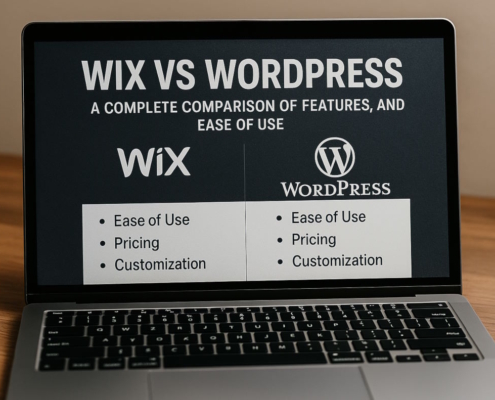Introduction
E-commerce platforms can help small business owners engage with clients and increase sales if they sell things online. The best platforms make this possible by providing capabilities for shipping, inventory control, website design, and payment processing. In terms of enabling website design, we discovered that companies like Squarespace and Shift4Shop were excellent. However, BigCommerce and Shopify offer excellent functionality for inventory and shipping, while Ecwid and other comparable platforms are inexpensive.
30 well-known e-commerce platforms were tested and polled, and they were assessed based on important criteria like price, functionality, customer service, and reputation. We have listed our picks for the top e-commerce platforms below.
2025’s Top E-Commerce Platforms
- Shift4shop: The best e-commerce platform for search engine optimization
- Squarespace: The best e-commerce platform for novices
- Ecwid: The best e-commerce platform having zero transaction fees
- Wix: The best e-commerce platform for self-employed and freelancers
- BigComemerce: The best e-commerce solution for dropshipping
- Shopify: The best e-commerce platform for growing your business
- Web.com: The best e-commerce platform for service companies
- Zoho Commerce: Top reporting and analytics functionalities
- Big Cartel: The best low-cost platform
- OpenCart: The best free e-commerce platform
1. Shift4Shop
Features
Customers will find your online store more easily if you follow best practices for SEO (search engine optimization), which can increase sales. In addition to offering an array of SEO features in the marketing portion of each account’s online store manager, Shift4Shop assists users in creating SEO-optimized websites with SEO elements integrated directly into e-stores.
Additionally, the vendor guarantees that the pages are responsive, which is important because search engines like Google give preference to mobile-friendliness when ranking websites. We also appreciate the beginner’s SEO guide that is included.
Pricing
We were unable to find a more distinctive price structure elsewhere than Shift4Shop. For example, you can get a forever-free subscription if your store processes at least $1,000 a month. This is a wonderful deal with the ability to post an infinite number of products. However, rates begin at $39 a month if you don’t satisfy that $1,000 requirement. You should generally only choose Shift4Shop if you are certain that you can meet the minimum sales requirement for the freebie, as other companies charge less.
Customer service
Shift4Shop’s customer care can be reached via email and phone. Unfortunately, unlike some of its rivals, this vendor doesn’t seem to offer live chat. You may find solutions to frequently asked questions on the extensive online knowledge base, which is standard across the e-commerce platforms that we studied.
Reputation
Shift4Shop received a small amount of feedback, and to be frank, it wasn’t the best. With fewer than 20 reviews, the provider has a Trustpilot rating of lower than 2.0 out of 5. Fewer than 40 feedbacks and a rating of less than four out of five stars are found for this company on G2. With little more than 100 reviews and a score of just 4.0 out of 5, Capterra has the best result. The information is scarce in comparison to certain providers who have thousands of ratings.
Pros
- Integrated SEO tools
- Web hosting is included.
- Tools for email marketing are included.
Cons
- There aren’t many online reviews accessible.
- No live chat assistance
- To use the free plan, you must sell $1,000 worth of goods each month.
2. Squarespace
Features
Squarespace provides helpful guidance for new users, guiding them through every stage of the process, from selecting a domain to promoting your website. For example, using built-in templates makes it simple to design your website, and using an AI (artificial intelligence) tool may assist you compose product descriptions more quickly. With built-in features to handle shipping, payment, fulfillment, & checkout, launching your store is simple.
Pricing
There is a fee associated with Squarespace’s numerous user-friendly features. The lowest starting monthly pricing for an e-commerce package is $27 for the Business package, and this company doesn’t offer a free-for-life option. Unlimited products are permitted under all three e-commerce options. Selecting a yearly plan will save you money; the cheapest plan will cost you a fair $17 each month.
Customer service
Like most e-commerce platforms, Squarespace offers a thorough knowledge base where customers can look for do-it-yourself solutions to problems. Email assistance is available around the clock, and live chat is open Monday to Friday from 4 a.m. to 8 p.m. No phone help is available.
Reputation
First, the positive news: There is a good volume of online comments regarding Squarespace. What’s the bad news? There are conflicting reviews. With over 3,000 ratings that average more than 4.5 out of 5, the provider does well on Capterra. On G2, where over 1,000 reviews have an average rating of over 4.0 stars, things appear to be going well as well. Squarespace, meanwhile, suffers on Trustpilot, where over 1,000 reviews yielded an average rating of just 1.0 stars out of 5.
Pros
- A good assortment of website templates
- AI assistance in building websites
- Integrations with accounting software included
Cons
- On the more expensive end of the spectrum
- Social media marketing is limited to premium programs.
- Not much capacity to modify websites beyond templates
3. Ecwid
Features
Because Ecwid doesn’t charge transaction fees, you will eventually earn more money. This is a good perk in contrast to certain companies that charge fees, like Shopify. Even with its free plan, Ecwid meets many of our requirements for an online store, including rapid site builders, free design themes, and free site hosting. The fact that this company offers privacy protection, data backups, and security upgrades further impressed us with their commitment to security.
Pricing
Ecwid only permits five products, even though it provides a forever-free plan. Additionally, its most affordable paid package is constrained, enabling only 100 products. Nevertheless, at $25 or $21 a month (paid annually), the prices are reasonable. In the event that you are a sole proprietor with few products to provide, it can be adequate.
Customer service
The level of customer support offered by Ecwid varies by plan tier. Email assistance is available to all plans Monday through Friday, and a self-help resource center is available whenever needed. A good addition is the video tutorials that are part of the support forum. Nevertheless, live chat is only accessible for the initial 30 days following signup for free programs. The only plans with regular access are higher tiers. Likewise, phone help is confined to the more expensive Business & Unlimited programs.
Reputation
We have difficulties locating a lot of ratings of Ecwid on internet review sites, similar to some of the other companies on this list. Less than 3.5 out of 5 ratings were identified in under four hundred Trustpilot reviews. A bit more than 4.5 ratings were averaged across roughly 600 reviews on Capterra. Lastly, on G2, we discovered fewer than 400 reviews with an average rating of over 4.5 stars. Overall review scores are greater than those of several alternatives, although there is still a small amount of data from which to draw judgments.
Pros
- No transaction costs
- All-inclusive free plan with hosting
- Extremely vigilant with security
Cons
- Product restrictions on low-cost and free plans
- Limited digital marketing tools for more affordable plans
- Configuring delivery costs can be a little confusing.
4. Wix
Features
You control your e-commerce company’s marketing, website, and customer service, among additional items, if you are a solopreneur. Wix offers a comprehensive solution that covers not only website building and hosting but additionally inventory management & customer refunds, making it simple to manage all those tasks.
The Core plan covers the fundamentals of e-commerce, including marketing tools, site analytics, and payment acceptance. You can work on different projects with the help of automated tools. A complimentary domain & events planner for the initial year is among the other time-limited benefits offered by Wix.
Pricing
With the cheapest paid e-commerce package costing $29 a month, Wix is a moderate option among the vendors we researched. For longer-term yearly agreements, Wix does not provide discounts, in contrast to several of its rivals. The cost is still $29 a month, with an annual billing cycle.
Wix does not have a free plan, but you can try it out with a trial period of fourteen days. The majority of e-commerce platforms we examined offer either a free trial that lasts three to thirty days or a free plan that allows you to test the offering out. This trial is rather typical across these platforms.
Customer service
Along with a self-help information library, Wix provides a good range of customer service choices. You can contact the team via phone, email, or live chat. Callbacks are available via phone at all times. Phone help is a good advantage, especially since other companies don’t offer it at all.
Reputation
With around 10,000 reviews, Wix has a significant number of ratings on Capterra. With nearly 4.5 stars overall, the rating is excellent. On additional platforms, however, the company’s performance is less satisfactory. There are fewer than 2,000 reviews on G2, with an average rating of just 4.0 stars. We discovered just ten reviews on Trustpilot, with an average rating of just over 2.0 out of 5. We did observe that Trustpilot reviewers were often more critical since several of the providers we polled did better on G2 and Capterra than on Trustpilot.
Pros
- Hosting is included.
- Inventory control is one of the features.
- Integrated feature for refunds and returns
Cons
- Tax calculators built in for higher-tier packages only
- Product limitations
- There’s no free plan offered.
5. BigCommerce
Features
Small business entrepreneurs in the e-commerce industry may find dropshipping to be an alluring business model since it eliminates the need for in-house inventory management. BigCommerce’s pre-made dropshipping provider database serves this market. Connecting BigCommerce with programs like Spark Shipping even makes it feasible to automate dropshipping. Additionally, the provider gives some helpful instructional resources that address the benefits and drawbacks of dropshipping for those who are new to the business concept.
Pricing
With a monthly subscription that starts at $39 and no gratis option, BigCommerce is on the pricier end of the price scale. You can save some money by choosing a long-term plan, which costs $29 a month and is billed annually, as is frequently the situation with e-commerce platforms. The positive aspect is that boundless products are included with even the most basic subscription. That hosting is not included is disappointing considering the higher costs.
The fact that every BigCommerce package has a sales limit is another feature we dislike. Stated differently, you are automatically promoted to the subsequent plan when you reach a specific threshold for each plan, like $50,000 in sales under the Standard plan.
Customer service
Even for its most affordable package, BigCommerce stands out for its round-the-clock technical support, which includes chat, phone, and ticket assistance. It helps ease your mind to know that you can always get in touch with someone. For instance, some companies only provide customer assistance during certain hours, while others don’t provide phone help at all. A knowledge resource, community forum, and extensive video series are all features of the comprehensive online assistance center.
Reputation
We saw a similar pattern in BigCommerce’s online feedback compared to those of its rivals. Feedback is generally more accessible on Capterra & G2, and both platforms have respectable ratings, with an average of over 4.0 stars. Things take a turn for the worse after you reach Trustpilot. The Trustpilot rating is just over 1.0 stars on average, based on less than 500 reviews. Compared to the other websites we surveyed, it appears that Trustpilot reviewers tend to be more critical.
Pros
- A directory of dropshipping suppliers is provided.
- Limitless products, even with the most basic plan
- Website themes are available for both paid and free use.
Cons
- The cost of web hosting is additional
- Prices are a little higher.
- Every plan has maximum sales
6. Shopify
Features
Even if you are a solopreneur and your firm is small at first, it may not remain that way. Your online presence will expand in tandem with the growth of your e-commerce store. Shopify’s several price plan tiers and straightforward upgrading process facilitate seamless scaling.
The cost of your prior plan will be prorated and allocated to the new plan’s pricing if you switch to a more expensive one. Limitless staff accounts, more inventory locations, and customized worldwide selling across fifty countries are among the possibilities made available by higher-tier plans.
Pricing
There is no free plan offered by Shopify, and the most affordable premium package is at the top end of the range, costing $39 or $29 a month with an annual subscription fee. Nevertheless, with an infinite number of products, ten inventory sites, and localized worldwide selling in three marketplaces, you get a fair deal. The free trial on Shopify is special. People can test out choices with the majority of rivals’ free-for-life plans or 14–30 day free trials. Shopify offers three days for free, followed by a $1 month.
Customer service
Shopify’s primary resource for clients seeking solutions is a self-help knowledge library, similar to the majority of the providers we studied. Live chat assistance is available around the clock for every plan level to complement this. Additional assistance options, such as phone support, are included in the highest-tier programs.
Reputation
On Trustpilot, we located over 2,000 evaluations for Shopify, the majority of which were negative. Out of five stars, the average rating was just over 1.0. Having received over 6,000 reviews with an average rating of roughly 4.5 stars on Capterra, Shopify performed significantly better. Similar success was achieved by the service on G2, where over 4,500 reviews yielded an average rating of over 4.0 stars.
Pros
- A wide variety of bundles at various pricing points
- Plans that are simple to upgrade
- Unlimited products, including the most affordable plan
Cons
- Only the plugin has a shipping calculator.
- Phone support is limited to the most expensive plan.
- Limited capabilities for marketing and blogging
7. Web.com
Features
There are some differences between selling items and selling services. Instead of listing a concrete product, you must sell time, which is an intangible. Featuring an appointment booking tool, Web.com’s e-commerce plan enables clients to pay electronically for workshops, classes, and events. Free for the initial three months, the provider’s e-commerce plan also includes some good extras, such as email and social media marketing resources and a business email.
Pricing
Compared to some of its competitors, Web.com charges prices that are nearly twice as costly. The e-commerce package is $34.99 a month, or $29.99 a month if you choose to upgrade to an annual plan, which is payable annually. There isn’t a free plan, however there is a nice 30-day trial available. Some benefits we didn’t find elsewhere, including an hour of professional design assistance to ensure your e-commerce store looks its best, come with an additional fee.
Customer service
Since Web.com is more expensive, we would anticipate better customer service. It delivers, which is wonderful news. This company provides round-the-clock live chat assistance in addition to phone and email support. The range of available hours and support options is more extensive than what many competitors provide. A self-help knowledge center is also available.
Reputation
Overall, Web.com’s feedback ratings are positive. Web.com receives nearly 4.0 out of 5 ratings on Trustpilot, whilst many of its rivals struggled to receive even 1.0 to 2.0 stars based on more than 2,000 reviews. With fewer than 200 reviews total on both Capterra & G2, the provider’s visibility on both platforms is weaker. Web.com receives more than 4.5 stars on G2, but fewer than 4.0 stars on Capterra.
Pros
- Enables appointment-based transactions
- A good assortment and accessibility of client service alternatives
- Pleasant extras, like help with web design
Cons
- Pricey
- The cost of web hosting is additional.
- Relocating current websites off of Web.com might be challenging.
8. Zoho Commerce
Features
A responsive site builder, free hosting, and SSL certificates are just a few of the essential features that Zoho Commerce offers. Moreover, marketing options like social media integrations and newsletter subscriptions are provided.
Our favorite elements of the platform are its analytics and reporting capabilities, which allow you to examine orders & transactions to determine which products are doing well and which are not. With the help of the AI-powered aid, you can gather and display important data and make “what-if” predictions about the future.
Pricing
Despite the lack of a free plan, Zoho Commerce is often a reasonably priced option. The cheapest paid package will cost you $27 or $22 a month, with an annual billing cycle. Even if the product limitation is 2,000 products, that’s a really good number that might meet the requirements of a modest company. Of course, if you need to, you can upgrade to a higher-tier service with more flexible limits. Up to fifty thousand products are permitted on the most expensive package.
Customer service
Use Zoho Commerce’s online knowledge library, which includes FAQs and user manuals, to find solutions to frequently asked questions. In addition, you can email the provider to request a callback, and they also have email support. While we couldn’t uncover any indication of chat assistance, there is a Zoho Community where you may ask other users questions and discuss popular subjects.
Reputation
Although it doesn’t seem like Zoho Commerce has its own Trustpilot review page, we managed to locate a generic review website for Zoho that features over 4,500 reviews and an average rating of over 4.0 stars. However, since Zoho offers a wide range of products to which these reviews may be related, we are unable to attest to the authenticity of this feedback.
It has fewer than 100 reviews with an average rating of slightly more than 4.0 stars, despite having a review section on G2 dedicated to Zoho Commerce. Comparably, Capterra offers a review website for Zoho Commerce, but more than 100 reviews with an average rating of a little over 4.0 stars are found there. We wouldn’t believe the web reviews overall because they are either vague or unrelated to Zoho’s e-commerce platform.
Pros
- AI-driven reporting and analytics
- Includes a wide range of marketing options, such as social integrations and newsletters.
- Emails for abandoned carts included
Cons
- Insufficient or untrustworthy internet reviews
- Limits on product numbers for lower-tier plans
- Customization restrictions for websites
9. Big Cartel
Features
Big Cartel offers e-commerce store essentials at a more affordable price than most, such as real-time sales monitoring and SEO optimization. Big Cartel is another option if you’re searching for a less expensive way to sell services than Web.com. By enabling you to offer appointment hours, reservations, or sessions, the supplier supports service-based enterprises.
Photographers and coaches are among the professionals who may find this useful. Then, you may incorporate a Google calendar into a personalized booking page so that guests can view future availability.
Pricing
Those on a tight budget may be happy to learn that Big Cartel offers a free version. The forever-free variant, as is typically the case, has restrictions and can only list five products. Even the most affordable premium plan, which begins at $15 a month or $12 a month payable annually, has a 50-product limit. Since Big Cartel is generally the least expensive of its rivals, these restrictions appear to be commensurate with the cost.
Customer service
The support staff can be reached via chat within the app if you possess a Big Cartel account. Another option is to send the team an email. An online support center featuring FAQs and how-to articles is also available. The hours for help are 8 a.m. to 6 p.m. ET on Saturdays and Sundays, and 24 hours a day, Monday through Friday.
Reputation
Big Cartel is barely present on the web review sites we looked at, and we didn’t get much response from them. There are fewer than 100 evaluations of the business on Trustpilot, with an average rating of roughly 3.0 stars. Less than Fifty reviews on G2 have an average rating of just 4.0 stars, whereas fewer than 20 reviews on Capterra have an average rating of little over one star. Despite the fact that the feedback isn’t bad, we would be cautious about it because there aren’t many responses overall.
Pros
- More affordable than many of its competitors
- Able to support service-oriented enterprises
- Designed with independent merchants in mind, especially creators
Cons
- There aren’t many internet reviews.
- There is no web hosting available.
- Comparatively few advanced applications and integrations
10. OpenCart
Features
A free edition will always have restrictions in terms of capabilities and features, and OpenCart’s free version is no different. The fact that there is no product limitation is a huge benefit. However, the OpenCart Cloud version is the only one that offers hosting. SSL is not included if hosting is not available. Additionally, several features—like a shipping calculation, tax calculator, and a cart recovery tool—can only be accessed using a third-party application.
Pricing
There are other companies on our list that provide free plans besides OpenCart. However, it is the sole provider with a free package that does not have any restrictions on the number of products and does not have any criteria (in contrast to Shift4Shop’s, which calls for a minimum of one thousand dollars in monthly turnover).
We chose it as the best free e-commerce platform because of this distinction. An infinite number of products are available for free. Nevertheless, the premium plan is one of the priciest we’ve seen, costing a whopping $59 a month, and there don’t appear to be any discounts for yearly plans.
Customer service
One of OpenCart’s customer support options is email, which is accessible daily, HK time, from 9:30 a.m. until 6:30 p.m. For an additional fee, you can have specialized technical support. For instance, a one-time bug patch costs $100, a password change costs $50, and updating your OpenCart edition starts at $300.
Depending on how dependent you are on the support staff, this unconventional approach to client service might result in significant additional expenses. Additionally, a database containing support documentation is available online.
Reputation
OpenCart has an average Trustpilot review rating of nearly 3.0 stars. But it’s based on fewer than 25 reviews. We would advise against placing too much faith in a few reviews. Less than 300 reviews have been posted on both G2 and Capterra, indicating the e-commerce platform’s relatively small presence on both sites. Similar to the Capterra rating, which also averages slightly above 4.0 stars, the G2 rating is slightly over 4.0 stars.
Pros
- Limitless products, even with the free plan
- No supplementary transaction costs
- Free templates for websites are accessible.
Cons
- Hosting is only accessible through OpenCart Cloud.
- Several simple e-commerce functions require a plugin
- Fewer options for store design templates
Methodology
In order to identify the top e-commerce platforms, we looked at competitors in the market and created a list of 21 candidates for in-depth analysis. Next, we compared these systems using 52 criteria points, which were divided into multiple categories like payment processing, website tools, value, and expert score.
Within each segment, we looked at particular data points, like whether the platform has email marketing tools and allows recurring payments. In order to learn how to set up a shop on the Internet, configure payment & shipping, and handle inventory, we carefully examined the user interface and experience of each platform.
The following are the main deciding elements:
- Expert Score: Weightage 20%
Our expert score is composed of four components that are rated equally important. We start by examining features, taking into account areas where suppliers differ from those we polled. We pay special attention to those features that would help business owners. Value for money is then looked into by comparing it against the features offered as against the price tag. Lastly, we take reputation, user numbers, and user-friendliness into account in order to define whether or not an average person can easily discover the tool and if expert knowledge is obligatory.
- Value: Weightage 30%
In the evaluation of price, we discuss the monthly price, and if available the yearly subscription fee. We also consider limitations that lower-tier plans: storefronts, and the number of products allowed have.
- App reviews: Weightage 6%
Some of the possible uses of many e-commerce solutions might benefit business owners who are more or less always on the move. Applications were assessed according to the reviews provided in the Google Play and Apple App Store.
- Customer reviews: Weightage 9%
Customer feedback on the features of the main e-commerce platforms offers insights into their advantages and disadvantages.
- Service & Support: Weightage 6%
Those with lots of work on their hands expect reliable customer service. We had to look for several forms of help available like FAQ or knowledge base, phone, email, and live chat help.
- Website tools & features: Weightage 15%
We looked at a number of elements that encompass the entire spectrum of setting up and maintaining an online store. We started by determining whether the providers had pre-made templates and designs or other tools for creating online stores.
We then evaluated the necessary features to launch a website and ensure its security, ranging from SSL certificates to the accessibility of hosting solutions and bespoke domains. We also searched for features like email marketing tools and social media integrations that would assist a business owner market their goods.
- Payment processing & Accounting: Weightage 5%
For online sellers, processing payments is a big concern. We evaluated things like accounting software integrations, transaction fees for processing payments, and the capacity to receive recurring payments.
- Additional features: Weightage 9%
Other aspects that we evaluated were centered on benefits that would make managing an online store easier. For instance, we searched for an integrated technology for recovering abandoned carts and processing returns and refunds. These components can streamline workflows and improve the daily shop operations, however, they are not absolutely required.
E-Commerce platform: What is it?
A software program called an e-commerce platform aids companies in creating and managing their online stores. Hosting, payment processing, website design, and more might all fall under this category. It’s all you need in one location to manage your store, to put it another way. E-commerce systems are exemplified by Squarespace, Wix, and Shopify.
It will be simple to create the precise store you require using the many capabilities and integrations that the top e-commerce platforms provide. Additionally, they will be user-friendly, allowing you to launch your store swiftly and effortlessly.
How to pick the best e-commerce platform?
If you’re buying an e-commerce platform for the first time, you might be unsure of how to evaluate products. We list a few of the key components that we wouldn’t skimp on below. Additionally, we highlight some “nice to possess” benefits that are beneficial to small business owners (though their absence isn’t always a deal-breaker).
Key features of the best e-commerce platform
An e-commerce platform should have certain features that you cannot live without. The attributes listed below are our primary priorities.
- Web hosting: Your e-commerce website cannot be put online without a host. We would advise giving preference to services that offer hosting in order to save yourself time and administrative stress (and maybe money).
- Accessibility of payment processing: Your clients will have more options if you can accept a variety of third-party payments. Inquire about the payment methods that the e-commerce platform accepts and the associated costs.
- Features for security: Since online stores gather sensitive payment information from clients, security is crucial. Keep an eye out for security measures like data encryption provided by SSL certificates.
- Tools for web creation: Features like site templates might quicken the process if you’re starting from scratch with your e-commerce website. While they aren’t required, they help speed up and simplify site setup.
- Marketing benefits: To increase sales, you want to advertise your online store. Features like email marketing tools and social media integrations assist you in doing just that. As previously said, these benefits can increase the likelihood that an e-shop will succeed, albeit they are not necessary.
Simple Usage
Web design is going to be made easier with features like drag-and-drop builders and pre-built templates on a solid e-commerce platform. Simplifying procedures can also be achieved by intuitive links with other resources, including social networking networks.
Customer Service
Sales could be lost if your e-commerce site is unavailable or has technical issues. You need to know that you can simply contact a dependable customer service team in case you need them. Look for a variety of help channels, including chat and email, and confirm the hours of operation.
Reputation
There is no better way to gauge a product’s true quality than by reading actual user reviews. Find out what others are saying about tech review sites like Trustpilot, G2, and Capterra. Checking app store reviews is another option if the e-commerce platform maintains an app.
Frequently Asked Questions
1. What is the best e-commerce platform for dropshipping?
Oberlo, which is among the most well-known dropshipping applications, was purchased by Shopify in 2017. When paired together, they seamlessly import items into your store so that customers can buy them.
2. Which platform for B2B e-commerce is the best?
Business-to-business sales are facilitated by the capability of every service listed in this guide. However, if larger enterprises sell to other companies in significant monthly numbers, they might want to explore enterprise-level systems. We would suggest looking at platforms like Web.com & Big Cartel that support both product and service selling, especially for B2B companies. This leaves alternatives open because many B2B industries, like marketing and accounting, are service-based.
3. How can I create a website for online shopping?
An e-commerce website can be constructed in a few different ways. You can utilize an e-commerce platform like BigCommerce or Shopify, which offers all the necessary tools to get you going. An Ecwid plugin can be used with WordPress as an alternative. A do-it-yourself website builder like Squarespace is the last option.
4. What is an e-commerce platform that is open-source?
You may view and change the code for the e-commerce website using open-source e-commerce systems. If you want to give your website unique features or integrations, this can be useful. OpenCart is an example of a well-known open-source platform.






























